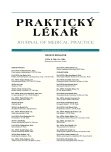Physical activity in the context of the postprandial metabolism of glucose and lipids
Authors:
E. Radzo
Authors‘ workplace:
Univerzita Komenského, Bratislava, Slovenská republika
; Prednosta: doc. MUDr. Tibor Marček, CSc., mim. prof.
; Klinika telovýchovného lekárstva, fyziatrie a rehabilitácie, Lekárska fakulta
Published in:
Prakt. Lék. 2012; 92(4): 203-205
Category:
Various Specialization
Overview
Metabolism in the human body is complex, regulated and affected not only by substances involved in metabolic processes but also by activity – physical exercise which is performed by the whole organism. There are differences in metabolism between men and women, however, with increased intensity of exercise, these differences are reduced. If physical exercise is implemented in the long term, even at lower intensity, it is an important factor for the physiological level of human lipaemia, glycaemia and insulinaemia with a prospective application, mainly in the field of preventive medicine.
Key words:
physical activity, metabolism, glucose, glycaemia, lipid, lipaemia.
Sources
1. Campfield, L.A., Smith, F.J. Blood glucose dynamics and control of meal initiation: a pattern detection and recognition theory. Physiol Rev, 2003, 83, p. 25–58.
2. Englert, V., Wells, K., Long, W., et al. Effect of acute prior exercise on glycemic and insulinemic indices. J Am Coll Nutr, 2006, 25, p. 195–202.
3. Ferreira, C.B., Souza, V.C., et al. The influence of intense intermittent versus moderate continuous exercise on postprandial lipemia. Clinics (Sao Paulo), 2011, 66(4), p. 535–541.
4. Folsom, A.R., Eckfeldt, J.H., Weitzman, S., et al. Relation of carotid artery wall thickness to diabetes mellitus, fasting glucose and insulin, body size, and physical activity. Atherosclerosis Risk in Communities (ARIC) Study Investigators. Stroke, 1994, 25, p. 66–73.
5. Friedlander, A.L., Casazza, G.A., Horning, M.A., et al. Training-induced alterations of carbohydrate metabolism in women: women respond differently from men. J Appl Physiol, 1998, 85, p. 1175–1186.
6. Ginsberg, H.N., Jones, J., Blaner, W.S., et al. Association of postprandial triglyceride and retinyl palmitate responses with newly diagnosed exercise-induced myocardial ischemia in middle-aged men and women. Arterioscler Thromb Vasc Biol, 1995, 15, p. 1829–1838
7. Hanefeld, M., Fischer, S., Julius, U., et al. Risk factors for myocardial infarction and death in newly detected NIDDM: the Diabetes Intervention Study, 11-year follow-up. Diabetologia, 1996, 39, p. 1577–1583.
8. Hanefeld, M., Fischer, S., Schmechel, H., et al. Diabetes Intervention Study. Multi-intervention trial in newly diagnosed NIDDM. Diabetes Care, 1991, 14, p. 308–317.
9. Hashimoto S, Ootani K, Hayashi S, Naito M. Acute effects of shortly pre- versus postprandial aerobic exercise on postprandial lipoprotein metabolism in healthy but sedentary young women. J Atheroscler Thromb, 2011, 18(10), p. 891–900.
10. Henderson, G.C., Fattor, J.A., Horning, M.A., et al. Lipolysis and fatty acid metabolism in men and women during the postexercise recovery period. J Physiol, 2007, 584, p. 963–981.
11. Katsanos, C.S., Grandjean, P.W., Moffatt, R.J. Effects of low and moderate exercise intensity on postprandial lipemia and postheparin plasma lipoprotein lipase activity in physically active men. J Appl Physiol, 2004, 96, p. 181–188.
12. King, N.A., Burley, V.J., Blundell, J.E. Exercise-induced suppression of appetite: effects on food intake and implications for energy balance. Eur J Clin Nutr, 1994, 48, p. 715–724.
13. King, N.A., Lluch, A., Stubbs, R.J., Blundell, J.E. High dose exercise does not increase hunger or energy intake in free living males. Eur J Clin Nutr, 1997, 51, p. 478–483.
14. Krzentowski, G., Pirnay, F., Luyckx, A.S., et al. Metabolic adaptations in post-exercise recovery. Clin Physiol, 1982, 2, p. 277–288.
15. Manders, R.J., Van Dijk, J..W, van Loon, L.J. Low-intensity exercise reduces the prevalence of hyperglycemia in type 2 diabetes. Med Sci Sports Exerc, 2010, 42(2), p. 219–225.
16. Marliss, E.B,, Kreisman, S..H, Manzon, A., et al. Gender differences in glucoregulatory responses to intense exercise. J Appl Physiol, 2000, 88(2), p. 457–466.
17. Miyashita, M., Stensel, D.J., Burns, S.F. Effect of exercise timing on postprandial lipaemia. J Atheroscler Thromb, 2011 Sep 29 [Epub ahead of print].
18. Niskanen, L., Rauramaa, R., Miettinen, H., et al. Carotid artery intima-media thickness in elderly patients with NIDDM and in nondiabetic subjects. Stroke, 1996, 27, p. 1986–1992.
19. Nordestgaard, B., Langsted, A., Freiberg, J. Nonfasting hyperlipidemia and cardiovascular disease. Curr Drug Targets, 2009. 10. p. 328–335.
20. O’Connor, A.M., Pola, S., Ward, B.M., et al. The gastroenteroinsular response to glucose ingestion during postexercise recovery. Am J Physiol Endocrinol Metab, 2006; 290, E1155–1161.
21. Paton, C., Brandauer, J., Weiss, E. et al. Hemostatic response to postprandial lipemia before and after exercise training. J Appl Physiol, 2006, 101, p. 316–321.
22. Plaisance, E., Mestek, M., Mahurin, A., et al. Postprandial triglyceride responses to aerobic exercise and extended-release niacin. Am J Clin Nutr, 2008, 88. p. 30–37.
23. Sharrett, A.R., Chambless, L.E., Heiss, G., et al. Association of postprandial triglyceride and retinyl palmitate responses with asymptomatic carotid artery atherosclerosis in middle-aged men and women. The Atherosclerosis Risk in Communities (ARIC) Study. Arterioscler Thromb Vasc Biol, 1995, 15, p. 2122–2129
24. Thompson, D.A., Wolfe, L.A., Eikelboom, R. Acute effects of exercise intensity on appetite in young men. Med Sci Sports Exerc, 1988, 20, p. 222–227.
Labels
General practitioner for children and adolescents General practitioner for adultsArticle was published in
General Practitioner

2012 Issue 4
Most read in this issue
- Asthma and nutrition: diet for the primary prevention and treatment of asthma
- Variants of human chromosomes and their significance from the point of view of clinical genetics
- What is the risk of disease caused by Legionella in the Czech Republic?
- The importance of histological verification of tumour metastasis
